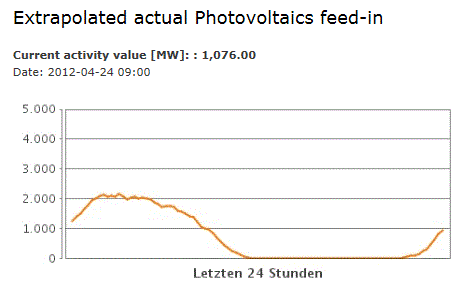I’d like to recommend the German Energy Blog to readers who’d like to know the latest about German energy news and issues. You may want to bookmark it.
Their latest article presents a resource called 50Hz:
Friday last week 50Hertz Transmission GmbH, the transmission system operator (TSO) whose grid covers large parts of Eastern and Northern Germany, started publishing the load flow data for its grid on the internet. It is the first TSO in Germany to do so.
Visitors of the web pages shall find an up-to-date map of the grid showing all power lines and interconnectors with other transmission grids. Network conditions shall be shown for the full hour. For a better understanding the lines shall be coloured depending on the specific load flow. Upon clicking on a power line, the load shall be given in megawatt (MW). The information is supplemented by data regarding special measures to secure system stability, i.e. …” (Continue reading)
It would be nice if all grid operators offered this service.
Especially the 50HZ Grid Data page offers up-to-date, interesting data on energy feed-in, etc.. For example here is photovoltaic feed-in for the last 24 hours:
Source: http://www.50hertz.com/en/2805.htm.







“Visitors of the web pages shall find an up-to-date map of the grid showing all power lines and interconnectors with other transmission grids. Network conditions shall be shown for the full hour. For a better understanding the lines shall be coloured depending on the specific load flow.”
Sounds a little bit like the commandments of the church of the renewables. Somebody posted a requirement doc ?
Very interesting! You can let a recording run and see what happened in the 50 Hertz grid in a given period of time. And most interesting is that during that re-run it shows messages flashing on and off, telling you which connectors or nodes were down, and, the best part, the sum of the “rejected” energy.
According to law EnWG § 13 ( law text: http://www.gesetze-im-internet.de/enwg_2005/__13.html ) a provider can order shutdown of renewable or other generators if needed to maintain stability of the grid. This is called “Summe der abgeregelten Strommengen” in the 50 Hertz website.
Sum for the first 3 months of 2012 is 1.8 million MWh. That’s equivalent to 1,800 hours of the output of a 1 GW power plant. A year has about 8,000 hours, so 3 months have 2,000 hours, so on average East Germany seems to lose about one such 1 GW power plant ALL THE TIME.
Don’t know if all this refused energy needs to be paid for in the form of FIT compensations…
Okay, according to this explanatory text
http://www.bundesnetzagentur.de/SharedDocs/Downloads/DE/BNetzA/Sachgebiete/Energie/ErneuerbareEnergienGesetz/LeitfadenEEGEinspeisemanagement/LeitfadenEEGEinspeisemanagement_pdf.pdf?__blob=publicationFile
the lion’s share of the “refused” energy happens according to §13(1); that means planned reduction of the output of regular power plants. The grid operator has to pay compensation to the plant operators IF such a compensation is contractually agreed. These reductions in output are necessary because the grid operator is required by law to always give renewable energies priority.
The cost for this is in the end paid for by the rate payer via the “transport fees” that are part of the consumer end price (about 7 cent IIRC).
So that’s another price driving consequence of the renewables, this time not manifesting itself in the 3.5 cent cross-subsidy but in the transport fees. Very interesting.
I don’t understand how legislators manage to protect such racketeering (esp. via EEG) from being overturned by the Constitutional Protection Court and Anti-Cartel Office.
Perhaps it’s all those years of fat in the EU where it became fashionable to be paid NOT to produce.
The European Court had to decide about it; somebody sued arguing that the principle of free exchange of goods is violated. The court ruled that there is a violation but due to the existential threat to the livability of the climate the violation is justified.
So they need the “C” in CAGW to keep on justifying the racket.
DirkH: “So they need the “C” in CAGW to keep on justifying the racket.”
Threats of personal harm … fits the bill.